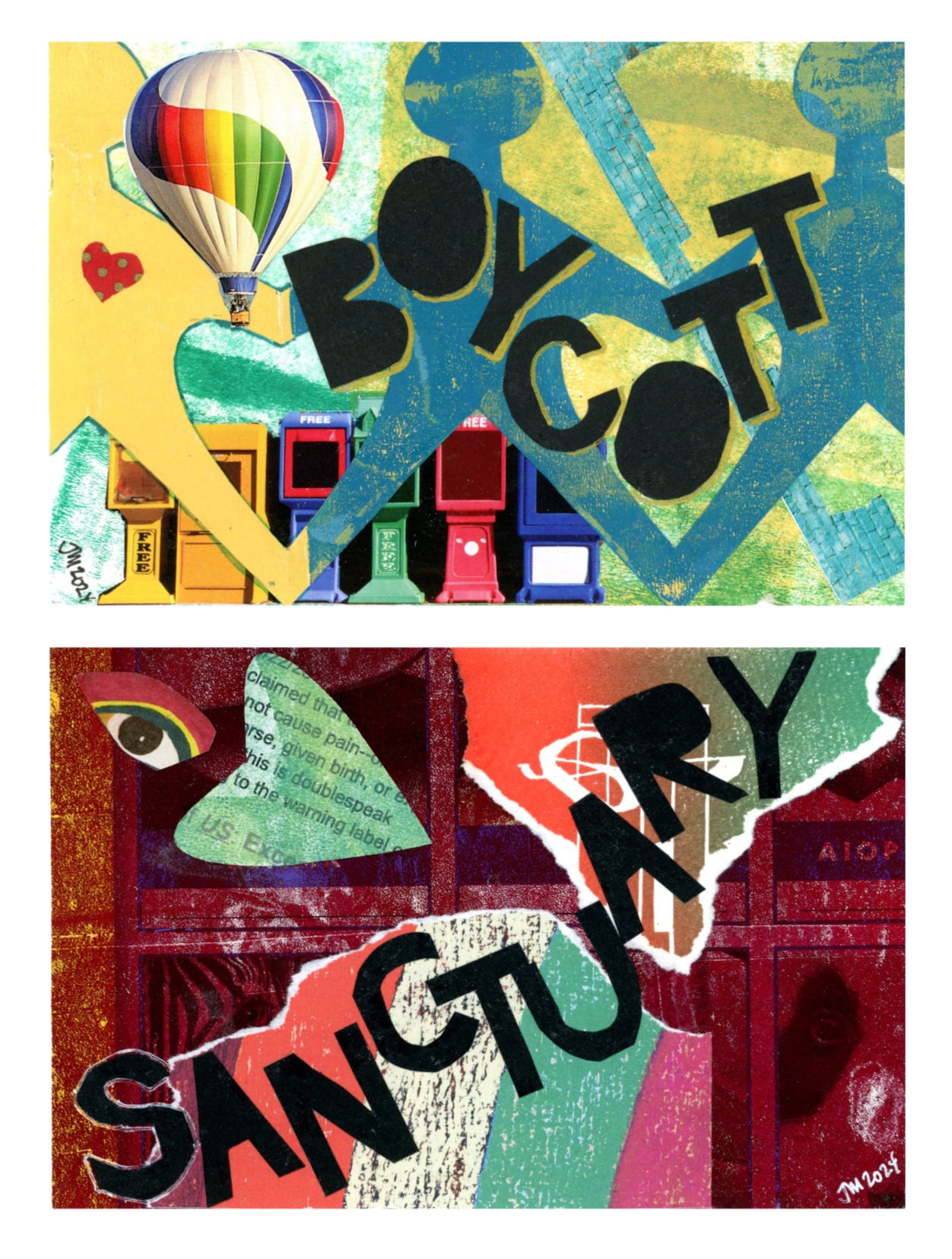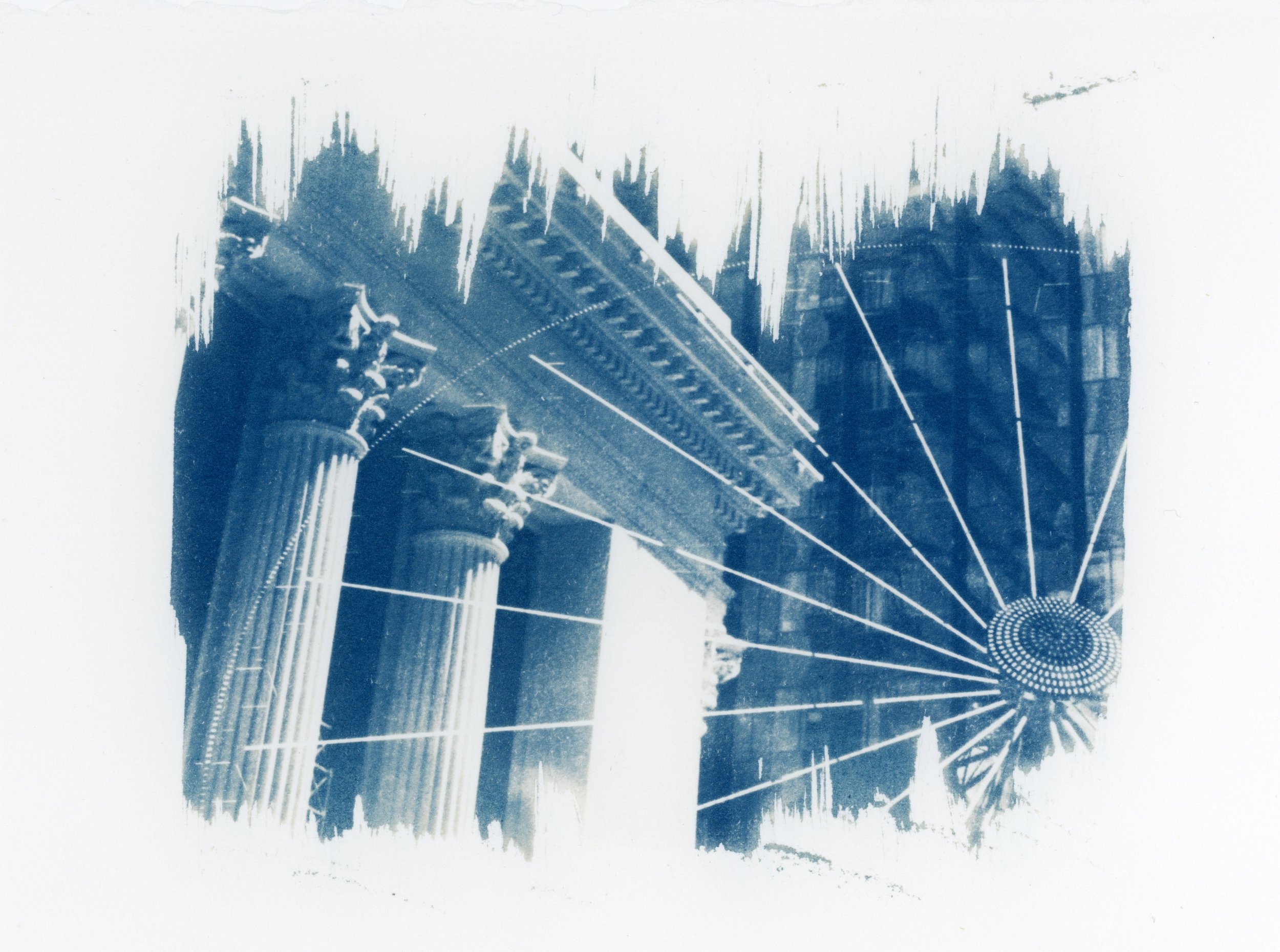
Social Justice Art
Art was my “second shift” between 2010 and 2024 and my artistic values have been shaped directly by both of the day jobs I held during this time. While teaching sociology to community college students in Silicon Valley, I came to recognize that people are often allergic to new facts and evidence, but art and storytelling can be the thin of the wedge that opens the door to new ideas. I began to incorporate collage into my sociology classes, using formative texts in the discipline, but also sociology always finds it way into my art-making (whether I want it to or not!). In 2021, I left teaching to become a full-time staff community organizer with Showing Up for Racial Justice (SURJ) in Santa Clara County CA, after having founded and coordinated SURJ’s Art and Culture Working Group as a volunteer starting in 2017. In developing and facilitating creative skills building workshops called Make Art Make Justice workshops for our local policy campaigns, I learned viscerally how art and creativity is central to relationship building, developing vision and imagination, suffusing joy into our organizing and developing messaging that moves people into action.

P Is For Power, from a set of 4 handmade alphabets for community organizers, 4 by 6 inches

Boycott and Sanctuary, from a set of 10 collages based on Gene Sharp's Nonviolent Resistance Tactics, 4 by 6 inches each

Step Out of Cogness, collage, 8 by 10 inches
Collages in Conversation with the Authoritarian Regime Survival Guide by Polish pro-democracy activist Martin Mycielski
As a participant chosen by the Kolaj Institute for its 2025 Politics in Collage residency, my charge was to make collages in conversation with a short guide written in 2017 by Martin Mycielski that warned Americans of what to watch out for based on the Polish experience. You can find a copy of the Authoritarian Regime Survival Guide here.

Who Is Watching the Watchers, mixed media collage, 10 by 14 inches

Seeing Red, mixed media collage, 10 by 14 inches

Throw It!, mixed media collage, 10 by 14 inches

The Words They Told Us We Cannot Use, mixed media collage with deconstructed text, 10 by 14 inches

Humpty Ain't Gonna Fall Off That Wall By Himself, mixed media collage, 10 by 14 inches

How to Stay Calm, mixed media collage, 10 by 14 inches

Everything Old Is New Again, mixed media collage, 10 by 14 inches

Champagne Dreams of the Oligarchs, mixed media collage, 10 by 14 inches

Pink Is For Girls, mixed media collage, 10 by 14 inches

What Is Liberty Made Of?, collage, 10 by 14 inches

Specific Suggestions for Simple Sabotage, mixed media collage, 10 by 14 inches

Divide and Conquer, collage, 10 by 14 inches

Finding Focus, mixed media collage, 10 by 14 inches

The Antidote, mixed media collage, 10 by 14 inches
Other works

An eight panel watercolor series that harvests lessons about community organizing from the coastal redwood forest, 5 by 7 inches each

Linocut postcard made to email elected officials to support immigrant rights, 4 by 6 inches

Linocut postcard made to mail to elected officials and/or voters, 4 by 6 inches

The Big Lie, mixed media collage, 18 by 24 inches
Suffragist Tea Parties, 2020
A socially engaged art installation in the Women Pathmakers exhibit in the Euphrat Museum of Art that asked participants to sit down over tea to discuss their relationship to voting and democracy. Participants were also given a Voting Rights Gazette broadsheet that educated about voter suppression and ways to strengthen democracy.
1893, On the Joys and Sorrows of Modernity
Exhibited during Fall 2019 in the San Mateo City Hall and San Mateo Public Library as part of the Art in Public Places program, 1893 is an ongoing project that explores the joys and sorrows of modernity. Sociologists like Anthony Giddens describe modernity as a set of historical transformations in both social structure and culture that include the rise of the nation-state, industrialization, the spread of capitalism, mass democracy as well as a cultural orientation toward the future and a belief in "progress." Max Weber saw rationalization as the central process of modernity. In a rationalized world, efficiency, predictability and quantification are highly valued. Weber warned that rationalization across all sectors of society would lead to the "disenchantment" of the world.
1893 explores the co-existence of rationalization and enchantment. In 1893, the first ferris wheel debuted at the World's Fair, also known as the Columbian Exposition, in Chicago. Chicago in the 1890s was the eye of the storm of modernity, knee deep in industrialization, labor disputes, immigration waves, and the rise of the social sciences. The ferris wheel has always been a personal symbol of enchantment to me and in this series it points to the joys of modernity. In the images, it is superimposed upon more ambivalent symbols of modernity. These images were made with alternative photographic processes available in the 1890s. Cyanotype and gum bichromate can be exposed with sunlight and developed in a sink. Yet, before that very hands-on low-fi process can begin, the images start life as digital files which can be taken in large quantities and handled with rational efficiency through software.

FBI Building, gum bichromate, 8 by 10 inches, 2023

The Myth of Progress, gum bichromate, 8 by 10 inches, 2025






